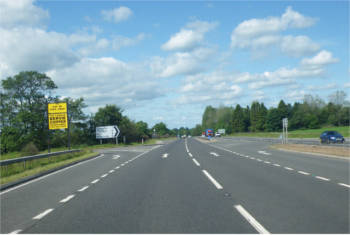Work to install average speed cameras on an 80km stretch of the A90 between Dundee and Stonehaven has begun.
In total, 30 Jenoptik SPECS cameras will be placed along the road, with 15 on each side.
A Transport Scotland spokesperson said: 'Preparatory work will initially focus on the section between Dundee and Forfar. The average speed camera equipment will not be installed until later in the summer with the full camera system expected to go live in the autumn.'

A stretch of the A9
The preparatory works will involve short-term lane closures and restrictions which will be outside peak periods on traffic sensitive parts of the route.
Transport Scotland said there were three fatal collisions and six serious collisions on this section of the route in 2015.
More than three in every five vehicles travelling between Dundee and Stonehaven are exceeding the speed limit, with more than one in every five vehicles exceeding the speed limit by more than 10mph.
Geoff Collins, Jenoptik’s sales & marketing director, said: ‘There are now four permanent SPECS average speed installations installed or planned for installation in Scotland, covering over 350km of roads.
‘The 80km long A90 scheme will use SPECS3 VECTOR, which is the newest but also most widely used average speed system in the UK – more than 50 UK sites currently use this camera, on top of the 50 sites that use earlier generations of SPECS cameras.’
Transport Scotland has hailed the continuing success of average speed cameras on the A9 between Dunblane and Inverness, despite recent fatalities on one section of the route.
Stuart Wilson, chair of the A9 Safety Group, said: ‘The longer term downward trend for casualty figures on the A9 is being supported by the latest data which considers the casualty figures over the 27 months since the average speed cameras were installed.
'The number of fatal and serious casualties between Dunblane and Inverness is down by almost 43%. There have been no fatal casualties between Dunblane and Perth and a reduction of almost 40% in fatal casualties between Perth and Inverness during the monitoring period.'
Register now for full access
Register just once to get unrestricted, real-time coverage of the issues and challenges facing UK transport and highways engineers.
Full website content includes the latest news, exclusive commentary from leading industry figures and detailed topical analysis of the highways, transportation, environment and place-shaping sectors.
Use the link below to register your details for full, free access.
Already a registered? Login